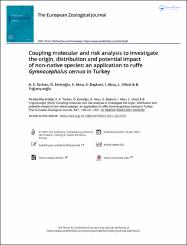| dc.contributor.author | Tarkan, Ali Serhan | |
| dc.contributor.author | Emiroğlu, Özgür | |
| dc.contributor.author | Aksu, Şadi | |
| dc.contributor.author | Başkurt, Sercan | |
| dc.contributor.author | Aksu, İsmail | |
| dc.contributor.author | Vilizzi, Lorenzo | |
| dc.contributor.author | Yoğurtçuoğlu, Baran | |
| dc.date.accessioned | 2022-11-23T12:26:43Z | |
| dc.date.available | 2022-11-23T12:26:43Z | |
| dc.date.issued | 2022 | en_US |
| dc.identifier.citation | Tarkan, A.S., Emiroglu, O., Aksu, S., Baskurt, S., Aksu, I., Vilizzi, L. & Yogurtcuoglu, B. (2022). Coupling molecular and risk analysis to investigate the origin, distribution and potential impact of non-native species: an application to ruffe Gymnocephalus cernua in Turkey. The European Zoological Journal, 89(1), 102-114. https://doi.org/10.1080/24750263.2021.2022222 | en_US |
| dc.identifier.issn | 2475-0263 | |
| dc.identifier.uri | https://doi.org/10.1080/24750263.2021.2022222 | |
| dc.identifier.uri | https://hdl.handle.net/11436/7127 | |
| dc.description.abstract | Increased detrimental impacts of biological invasions have triggered the development of risk screening tools to streamline the identification of the invasive potential of organisms. These tools assess the biological and historical characteristics of non-native species and predict their invasiveness in a given geographical area. However, challenges for identifying such invasive potential often require a holistic approach, if more accurate predictions are needed. Here, a case study is provided that combines molecular analysis (mtDNA barcoding) with a risk screening (Aquatic Species Invasiveness Screening Kit: AS-ISK) and impact assessment scheme (Environmental Impact Classification for Alien Taxa: EICAT) to address the origin, distribution and potential impact of non-native ruffe Gymnocephalus cernua in Turkey. Recently, several populations of this species have been recorded from the Turkish region of Thrace (the European part of Turkey), which represents the species' southernmost geographic range of expansion in Europe, where it is non-native. Molecular data suggested the inclusion of populations from Thrace in a haplogroup widespread in eastern and western Europe from where they might have been introduced, as well as natural spread of the species into Thrace through connected river systems rather than by intentional transport. The AS-ISK scores, also accounting for the effects of climate change, indicated that G. cernua is likely to pose a high risk of being invasive in Thrace but a medium risk in Anatolia (the Asian part of Turkey), and the EICAT scores indicated "major" impact. This study suggests that, in the near future, G. cernua has a high potential to invade all suitable habitats in Thrace and establish viable populations in several Turkish freshwater ecosystems, including those in Anatolia. | en_US |
| dc.language.iso | eng | en_US |
| dc.publisher | Taylor & Francis Ltd. | en_US |
| dc.rights | info:eu-repo/semantics/openAccess | en_US |
| dc.subject | Cytochrome c oxidase subunit 1 | en_US |
| dc.subject | Aquatic species invasiveness screening kit | en_US |
| dc.subject | Environmental impact classification for alien taxa | en_US |
| dc.subject | Thrace | en_US |
| dc.subject | Anatolia | en_US |
| dc.title | Coupling molecular and risk analysis to investigate the origin, distribution and potential impact of non-native species: an application to ruffe Gymnocephalus cernua in Turkey | en_US |
| dc.type | article | en_US |
| dc.contributor.department | RTEÜ, Su Ürünleri Fakültesi, Su Ürünleri Temel Bilimler Bölümü | en_US |
| dc.contributor.institutionauthor | Aksu, İsmail | |
| dc.identifier.doi | 10.1080/24750263.2021.2022222 | en_US |
| dc.identifier.volume | 89 | en_US |
| dc.identifier.issue | 1 | en_US |
| dc.identifier.startpage | 102 | en_US |
| dc.identifier.endpage | 114 | en_US |
| dc.relation.journal | The European Zoological Journal | en_US |
| dc.relation.publicationcategory | Makale - Uluslararası Hakemli Dergi - Kurum Öğretim Elemanı | en_US |


















